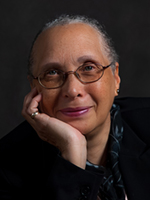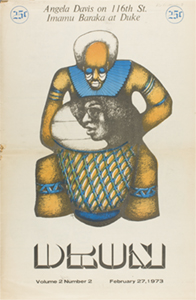
Connie Harold
Class of 1975, Communications Design, Black Student Union Participant
April 7, 2020
“to bring closer together what was going on on the campus and what was going on out in the world…”

Designed by Connie Harold
Early Education
Connie Harold came to Pratt in 1971 from Detroit, with a dedicated scholarship connected to her specialized art and design public high school. In her oral history, Harold describes her trajectory as an artist and designer beginning with her engagement with youth art programs in Detroit from an early age. She was also influenced by the legacy of her grandmother who had attended Pratt in 1912: “So you know, I had spent my childhood growing up thinking of myself as an artist, being an artist.”
The Black Student Union (BSU)
Harold describes her experiences with Pratt’s Black Student Union, starting in her first year when she participated in making demands for a community-based summer program at Pratt for local youth to provide the same kind of access to art and design she had benefited from in Detroit. She was part of the BSU group that wrote a proposal for the program including the need for a new community-liaison position to help run the program. According to Harold, the community liaison position was “to bring closer together what was going on on the campus and what was going on out in the world.” The proposal became a reality with the funding of the summer youth program and Harold’s participation in the hiring of Horace Williams, a Pratt alum, as community liaison. Harold eventually taught in the program in the summer as a Pratt student.
Harold recalls how BSU activists also made closer connections between the campus and the world through participation in national politics. She mentions Shirley Chisholm’s campaign and one of the BSU leader’s participation in national politics through the Black Convention in 1972 in Gary, Indiana, who came back “fired up” and saying, “why aren’t people doing this, doing that?” Harold eventually participated in a local campaign to elect Roger Green, the first Black city council member from the Pratt area.
She also describes other connections between Pratt and the outside world. Harold describes BSU demands for Pratt to hire Black, Puerto Rican, and Asian instructors and to develop greater connections to careers in the real world. As she progressed through Pratt, Harold served as an illustrator for The DRUM [a publication by the BSU] in “two or three issues that came out of the strike.” Harold describes her subsequent interest in “how art was used in commercial ways, not just protest, but just in general in how it influenced people’s thinking. That was a lot of my interest.”